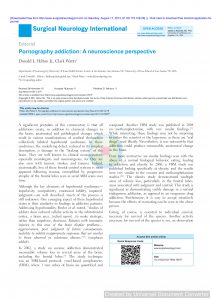Mental Health
Pornography Addiction: A Neuroscience Perspective
 Full Article Name: Pornography Addiction: A Neuroscience Perspective
Full Article Name: Pornography Addiction: A Neuroscience Perspective
Open Access: Yes
Abstract
A significant postulate of this commentary is that all addictions create, in addition to chemical changes in the brain, anatomical and pathological changes which result in various manifestations of cerebral dysfunction collectively labeled hypofrontal syndromes. In these syndromes, the underlying defect, reduced to its simplest description, is damage to the “braking system” of the brain. They are well known to clinical neuroscientists, especially neurologists and neurosurgeons, for they are also seen with tumors, strokes, and trauma. Indeed, anatomically, loss of these frontal control systems is most apparent following trauma, exemplified by progressive atrophy of the frontal lobes seen in serial MRI scans over time.
Relevance
“A significant postulate of this commentary is that all addictions create, in addition to chemical changes in the brain, anatomical and pathological changes which result in various manifestations of cerebral dysfunction collectively labeled hypofrontal syndromes. In these syndromes, the underlying defect, reduced to its simplest description, is damage to the “braking system” of the brain.” This results in “impulsivity, compulsivity, emotional lability, impaired judgment.”
Citation
Hilton, D. L., & Watts, C. (2011). Pornography addiction: a neuroscience perspective. Surgical Neurology International, 2, 19–19. https://doi.org/10.4103/2152-7806.76977
